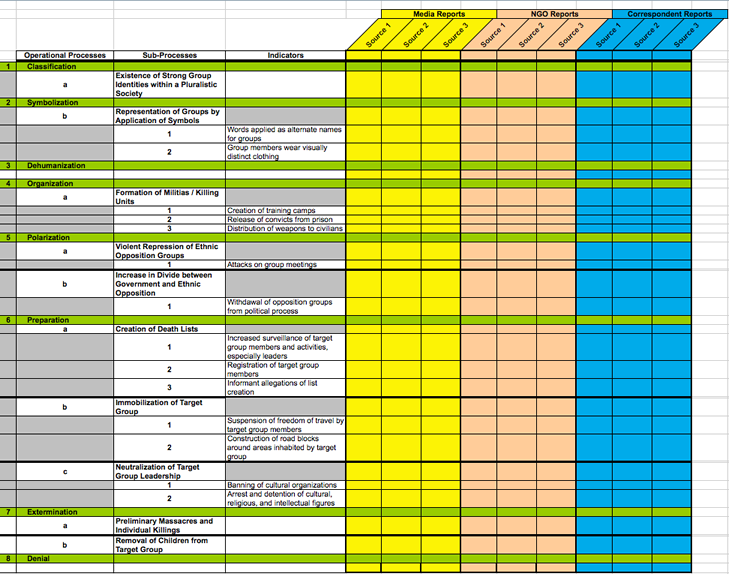We have been making some good progress on developing our Early Warning System (EWS), a rigorous and transparent process for monitoring and predicting when a community is at risk of genocide. In the spirit of making our process “open source”, I am sharing some of the details of what we have so far. This post will be the first part of what will eventually be a three-part series.
I want to emphasize here that these details are only tentative and an early draft that we are iterating several times over. If this were a software product, we are not yet at the “Beta” stage.
The core of our concept is based on the eight stage model of genocide emergence developed by Gregory Stanton. At the macro level, this model characterizes genocide as emerging from a combination of eight operational processes: Classification, Symbolization, Dehumanization, Organization, Polarization, Preparation, Extermination, and Denial.
Our approach is to begin with this framework and develop an efficient way of characterizing the presence of these factors in a particular situation. We are dividing up the work into a multi-stage process.
Phase 1: Risk Factor Assessment
The first step is to conduct an annual or semi-annual “global review”, where we look over as many communities and regions of the world as possible and compare them against what is essentially a checklist of risk factors that would generally predispose a society towards genocidal violence – for example, the weakening of democratic institutions, economic problems, or increases in ethnic grievances. We then focus on the communities with the greatest/strongest group of risk factors and formally initiate a “Situation of Concern” for each one. That leads us to the second stage of the process…
Phase 2: Situation of Concern monitoring
Each situation-of-concern (SOC) is a dedicated effort setup by us focused on a specific community or region that has been identified in our initial Risk Factor Assessment stage.
The goals of setting up the SOC are to:
1. Commit a team of analysts dedicated to maintaining a round-the-clock monitoring effort on the region
2. Begin a systematic process of disseminating situation updates and assessments (including warnings)
3. Actively begin establishing links with local community organizations and leaders within the at-risk country who can be both a source of data and also a point of distribution of our assessments and warnings
4. Establish a domestic distribution network of advocacy groups, community groups, media and other organizations and leaders within Canada, the United States, and Europe to whom we will broadcast our assessments and warnings
5. Develop strategies for action that can be offered as assistance to targeted community groups
The core process driving everything at this stage is the monitoring and assessment loop – we collect as much information as possible, and maintain a rolling assessment of how the risk of genocide is evolving in that region. To do this, we need two things:
1. A framework for storing and classifying all the information that we collect about a specific SOC into a “situation model” of that region
2. A framework for mapping our situation model to the “red flag model.” Essentially, there are specific signs and patterns that we are looking for that have typically been present ahead of genocides in the past. If our situation model contains similar signs and patterns and maintains increasing consistency with these red flags, then we have increasing reason to believe that violence may be imminent.
As I mentioned at the beginning of this post, we are using the Eight Stage model of genocide. Based on this, we have started developing an classification matrix that allows us to code each incoming data point that we have about an SOC with multiple categories. These categories allow us to frame all of our knowledge about an SOC directly in the context of the Eight Stage model. For example, every data point will be coded to indicate which warning signs (and subsequently, which of the larger eight operational processes) of violence the data is supporting. This will allow us to build a situation model that is made up of groups of data points clustered by time and theme that evolve over time.
Below is a very early rough example of the sort of classification matrix that we are designing.

The challenges here are to properly capture and map the significance and meaning of each data point into our overall situation model. Some data points are going to be more reliable than others – for example an allegation heard in a conversation with an unreliable source versus photographic evidence of a particular event. Some data points are going to be more significant than others and must have a bigger impact on our model. And data points are going to help either support or oppose the presence of the eight operational processes that we are looking for in the situation – we need to therefore have an accurate way of reflecting data in our situational model that actively supports that a genocide is not likely to happen.
All this is independent of the people+software process that we need to enable this workflow. We need a set of software tools that lets us build these situation models easily and with low overhead. And we need something that we can train up volunteers on easily, each time we setup a new SOC with a new team of analysts and translators.
In the next part of this series, I will discuss what we do once we have a basic situational model going – how do we decide when we have seen enough warning signs that there is an imminent risk of genocide? How do we decide when there is not such a risk and that the SOC should be discontinued? I will talk about intent and typology assessments and the challenges of communicating urgency when developing warnings.
Stay Tuned!
Taneem Talukdar
Engineering Team
